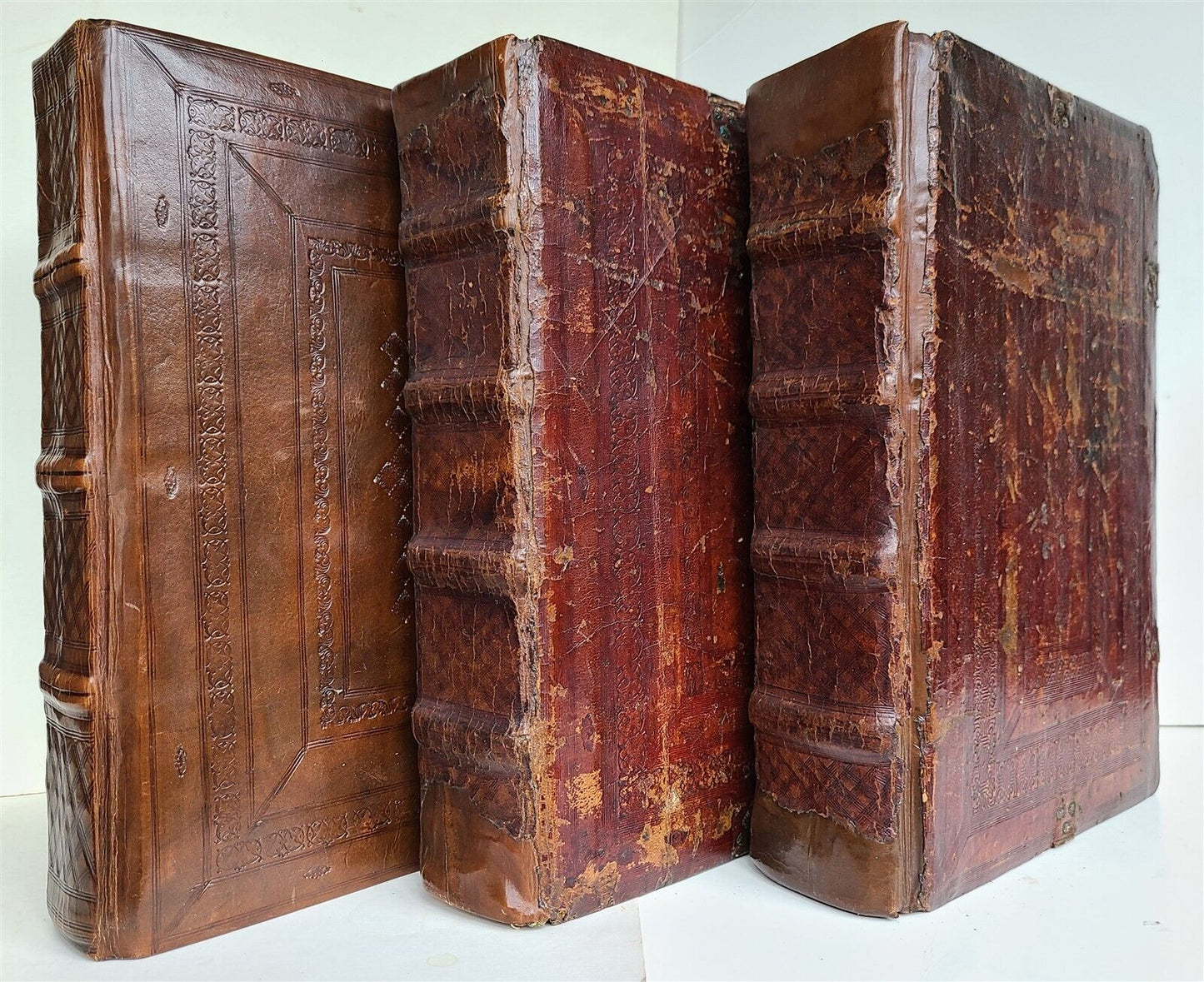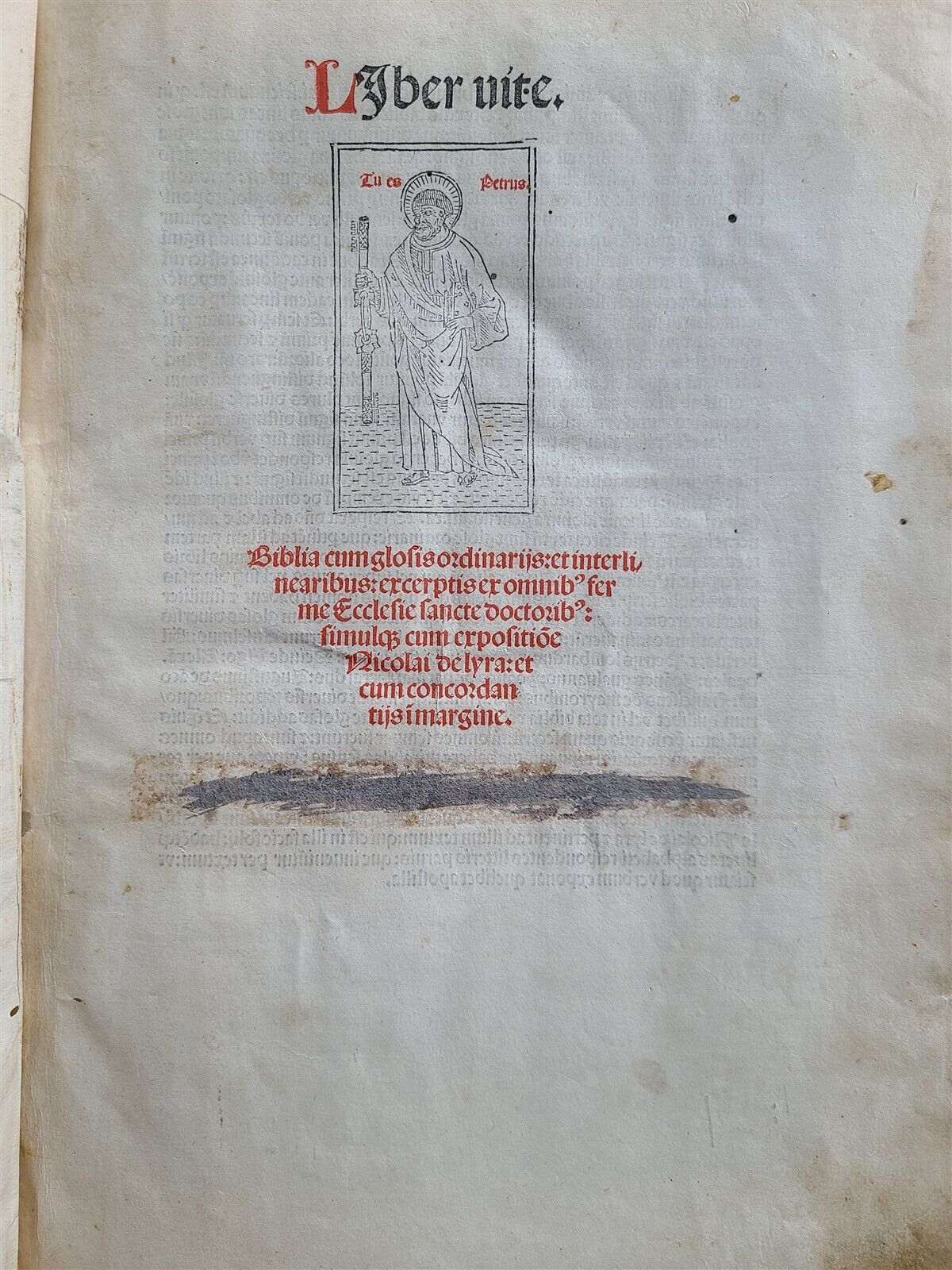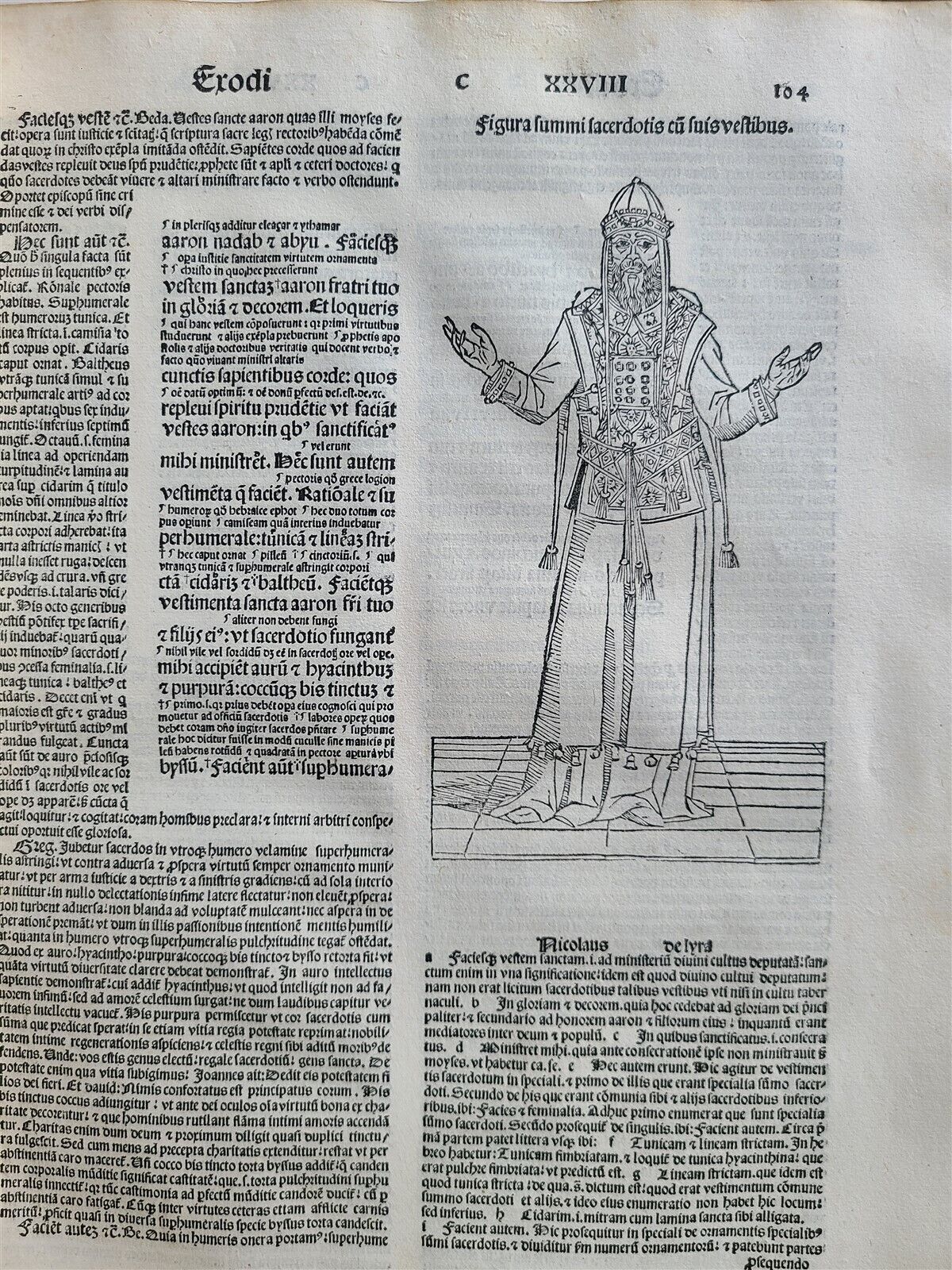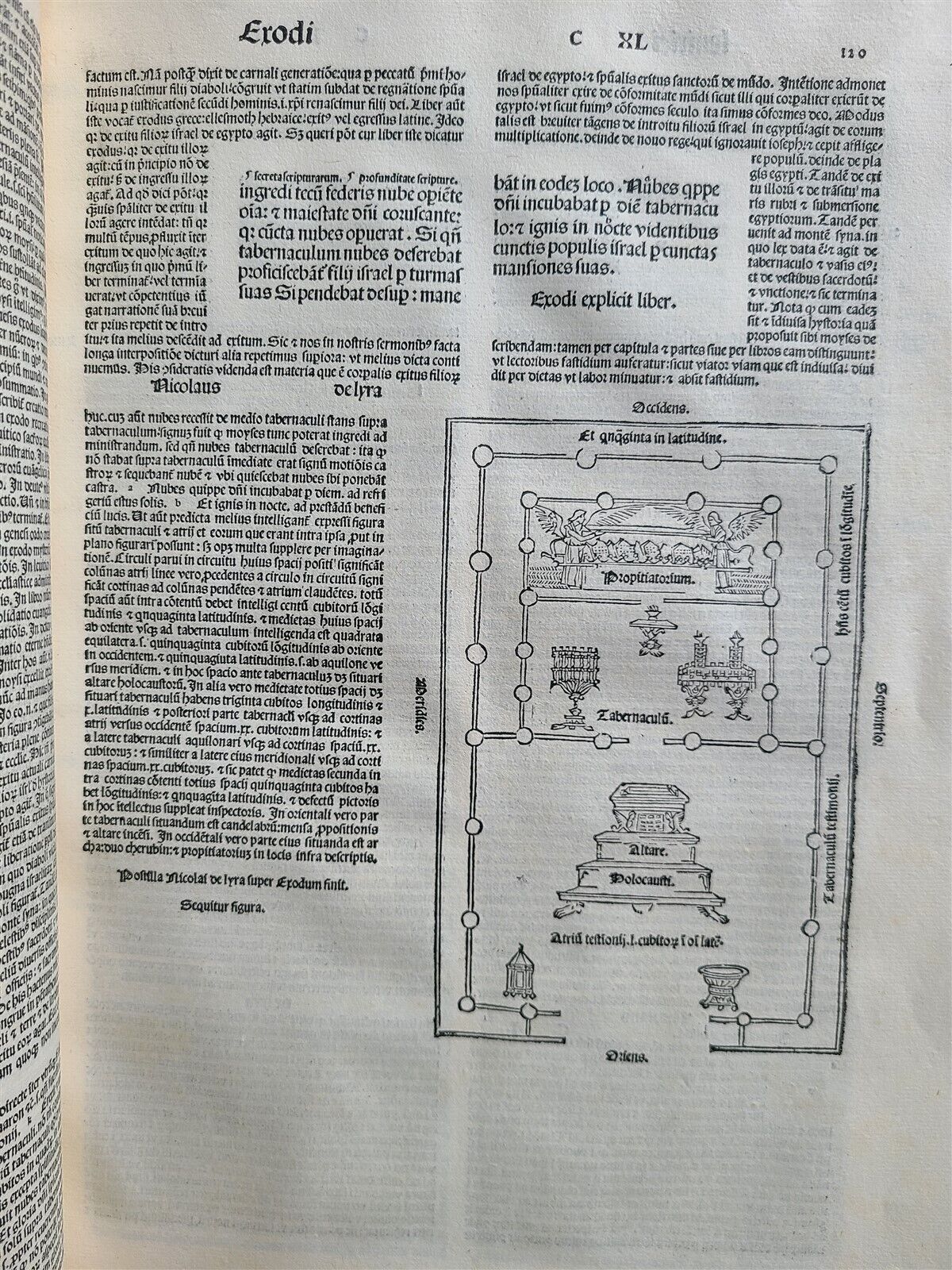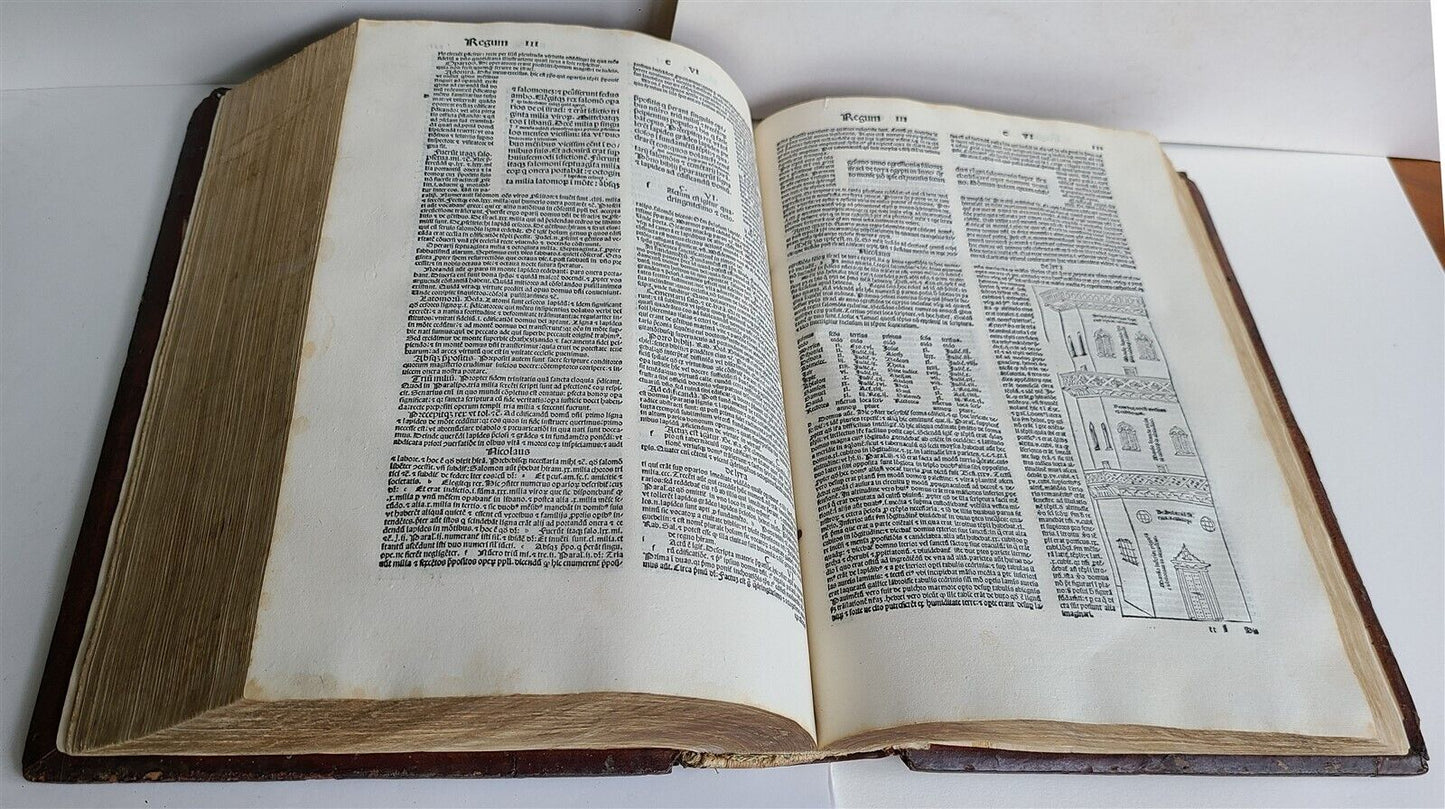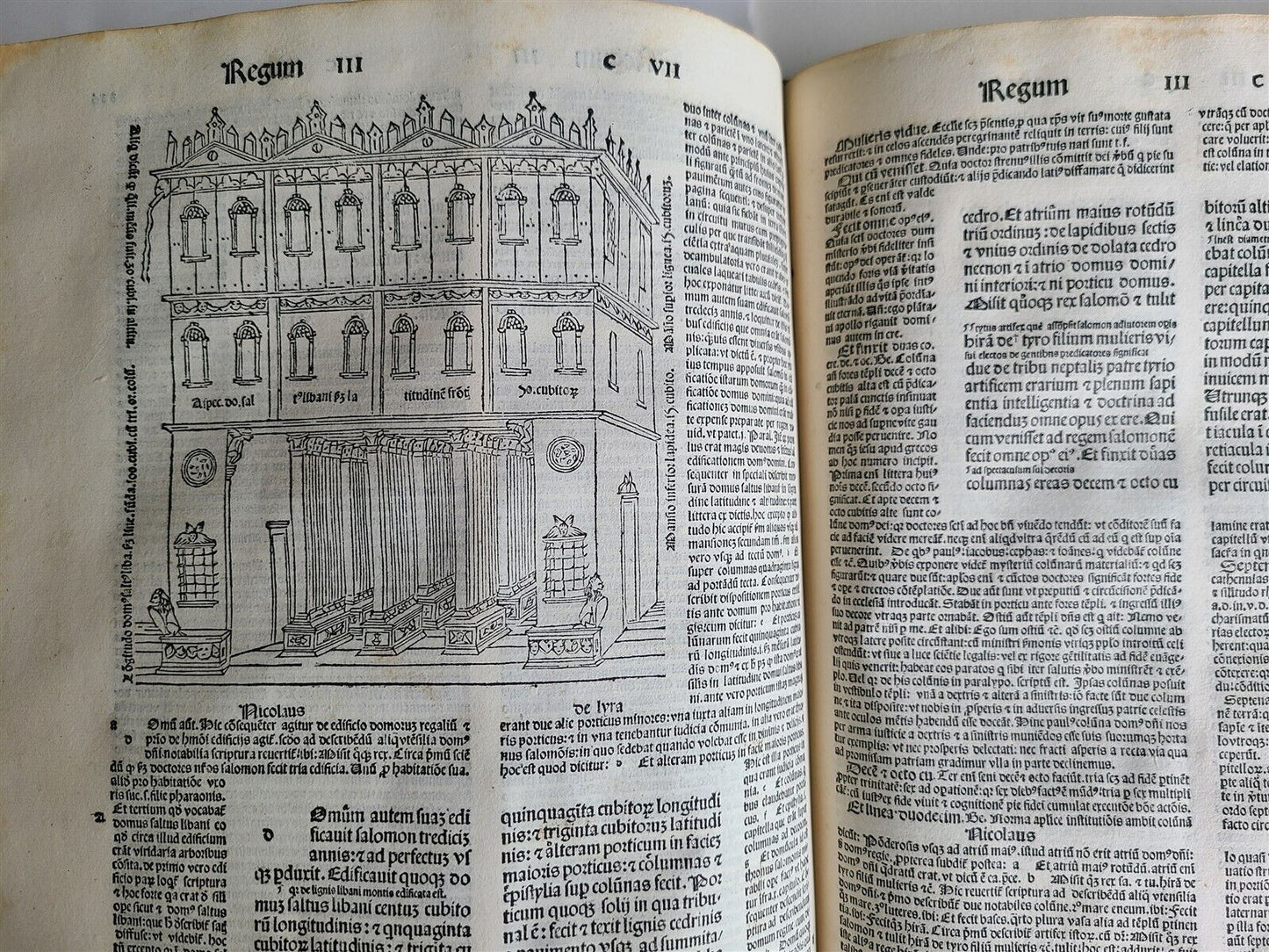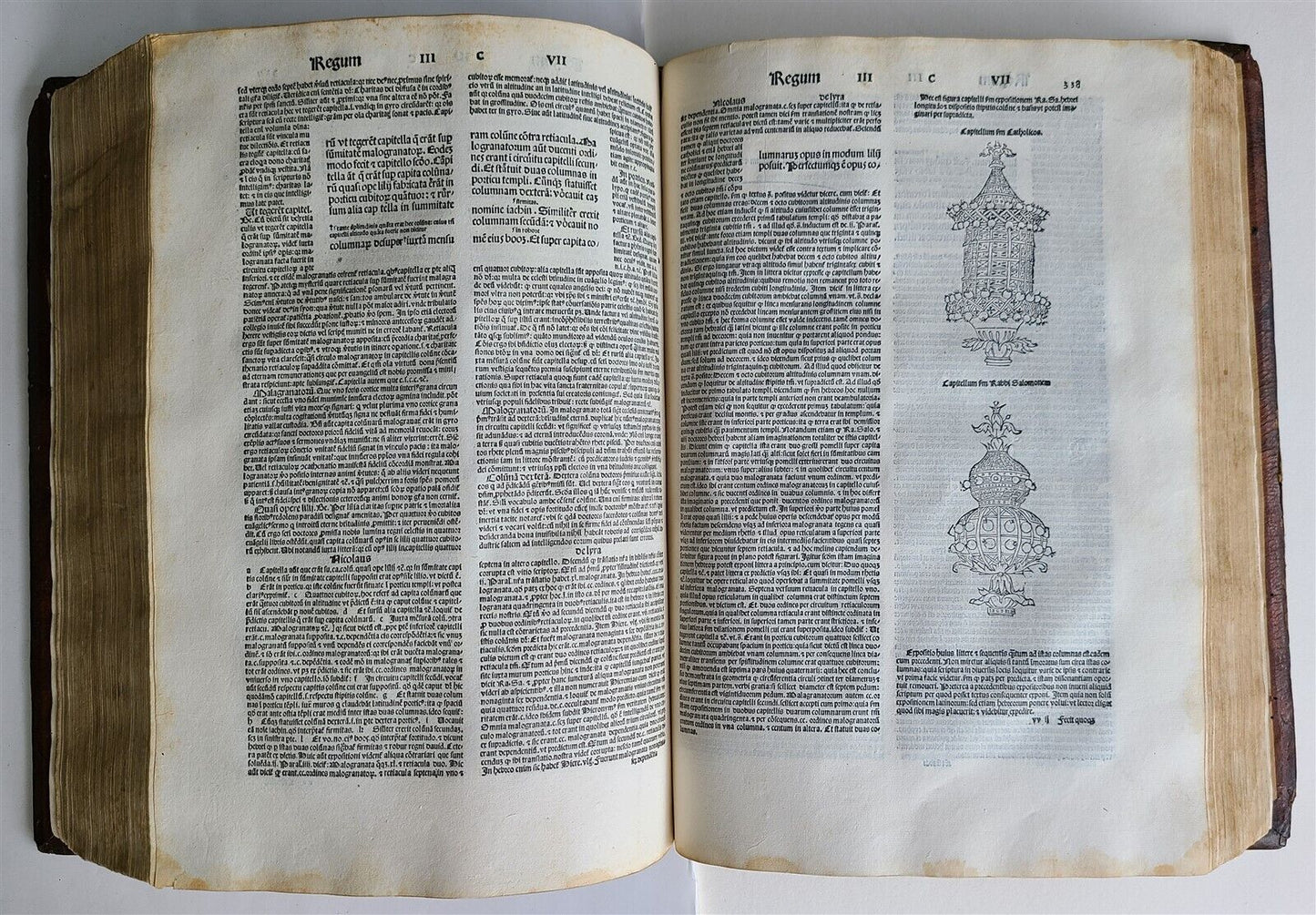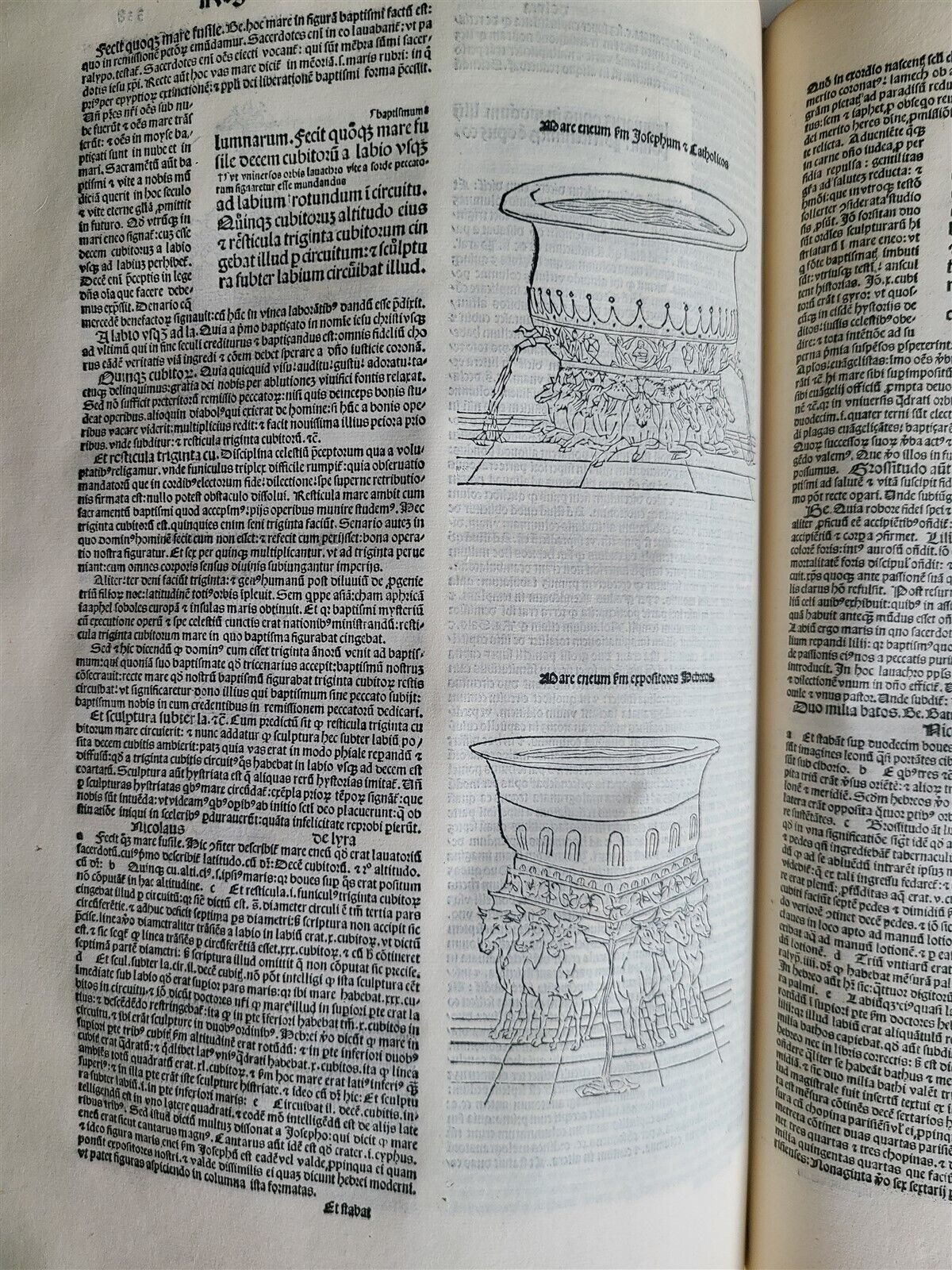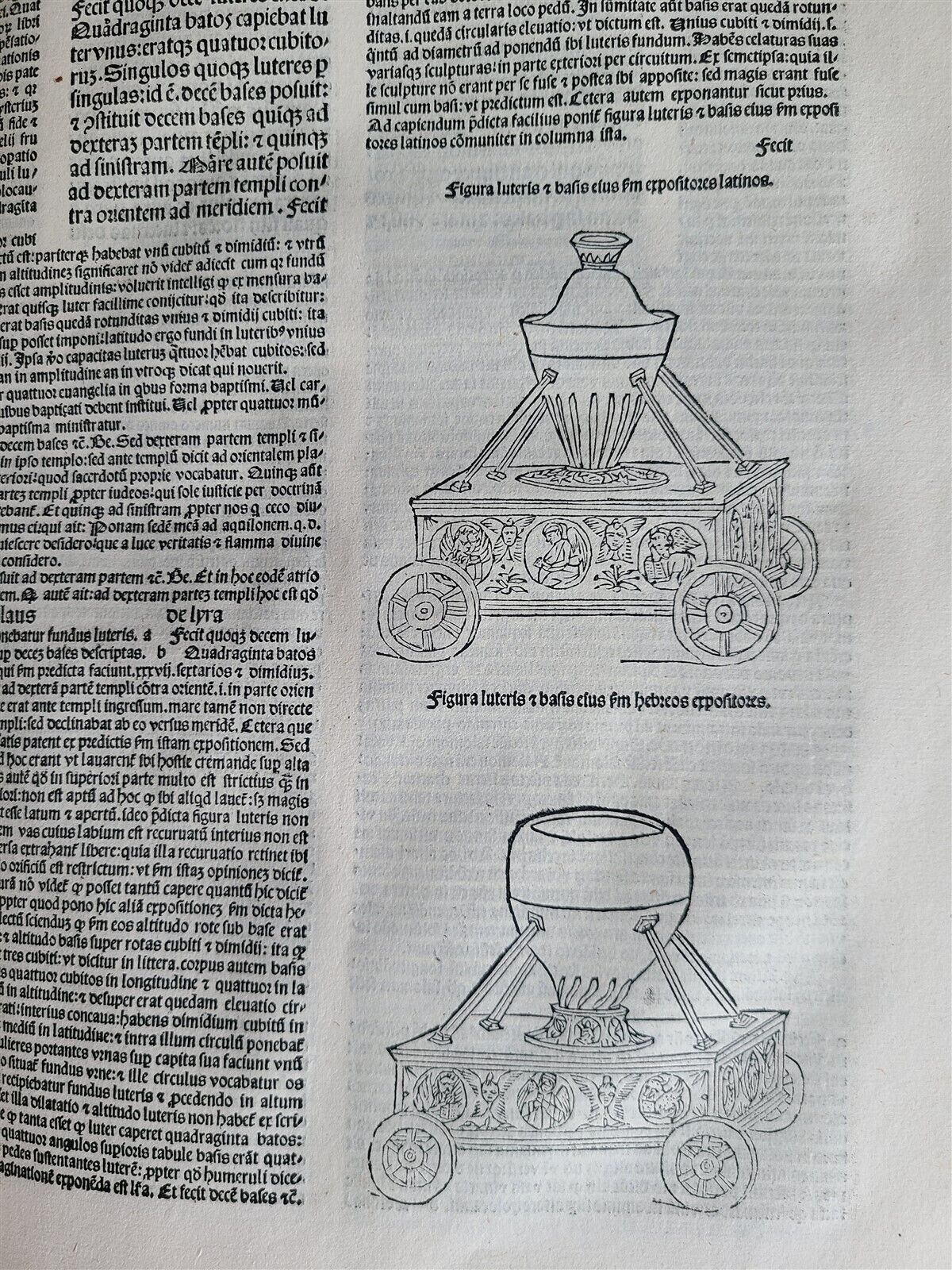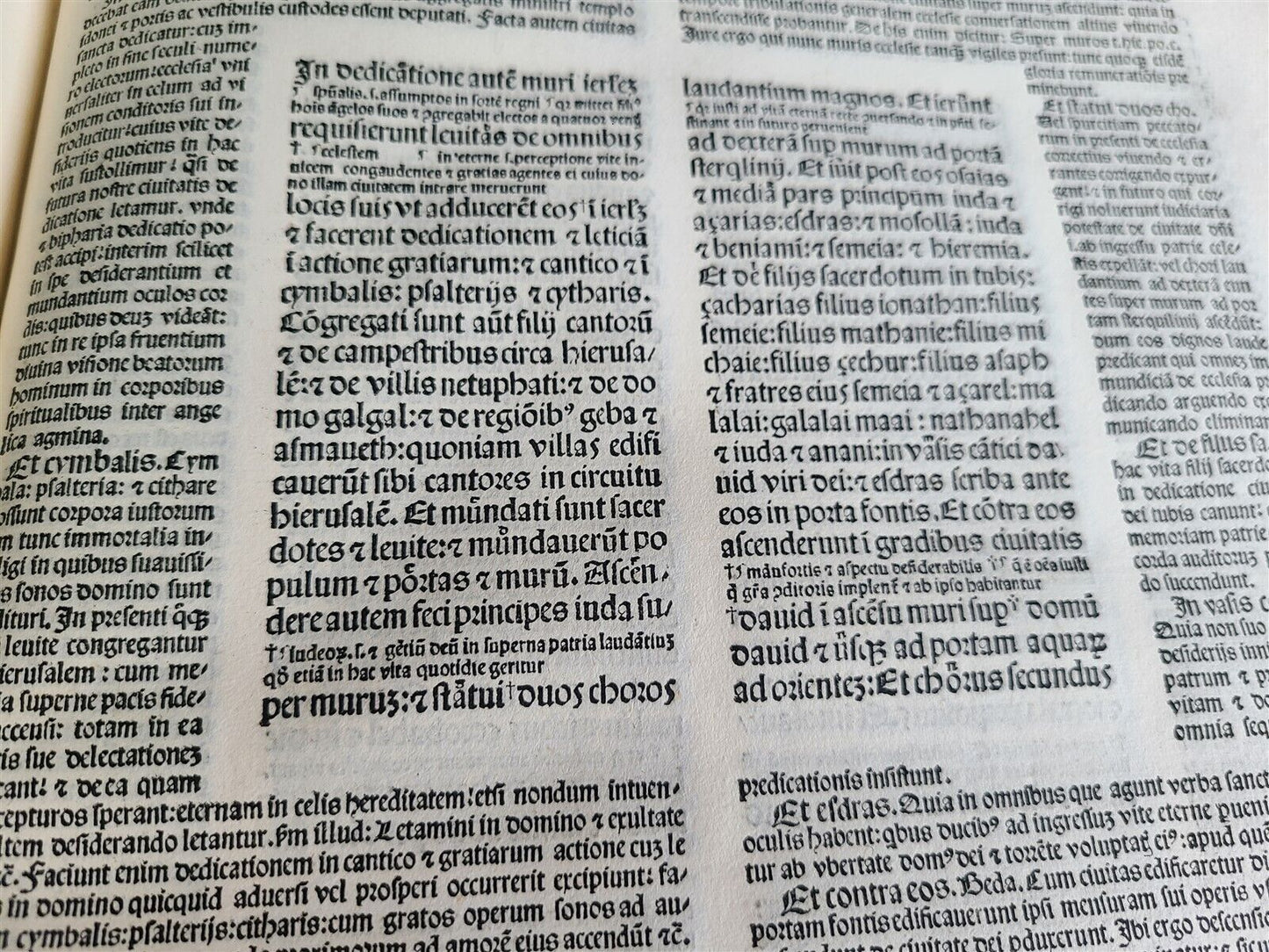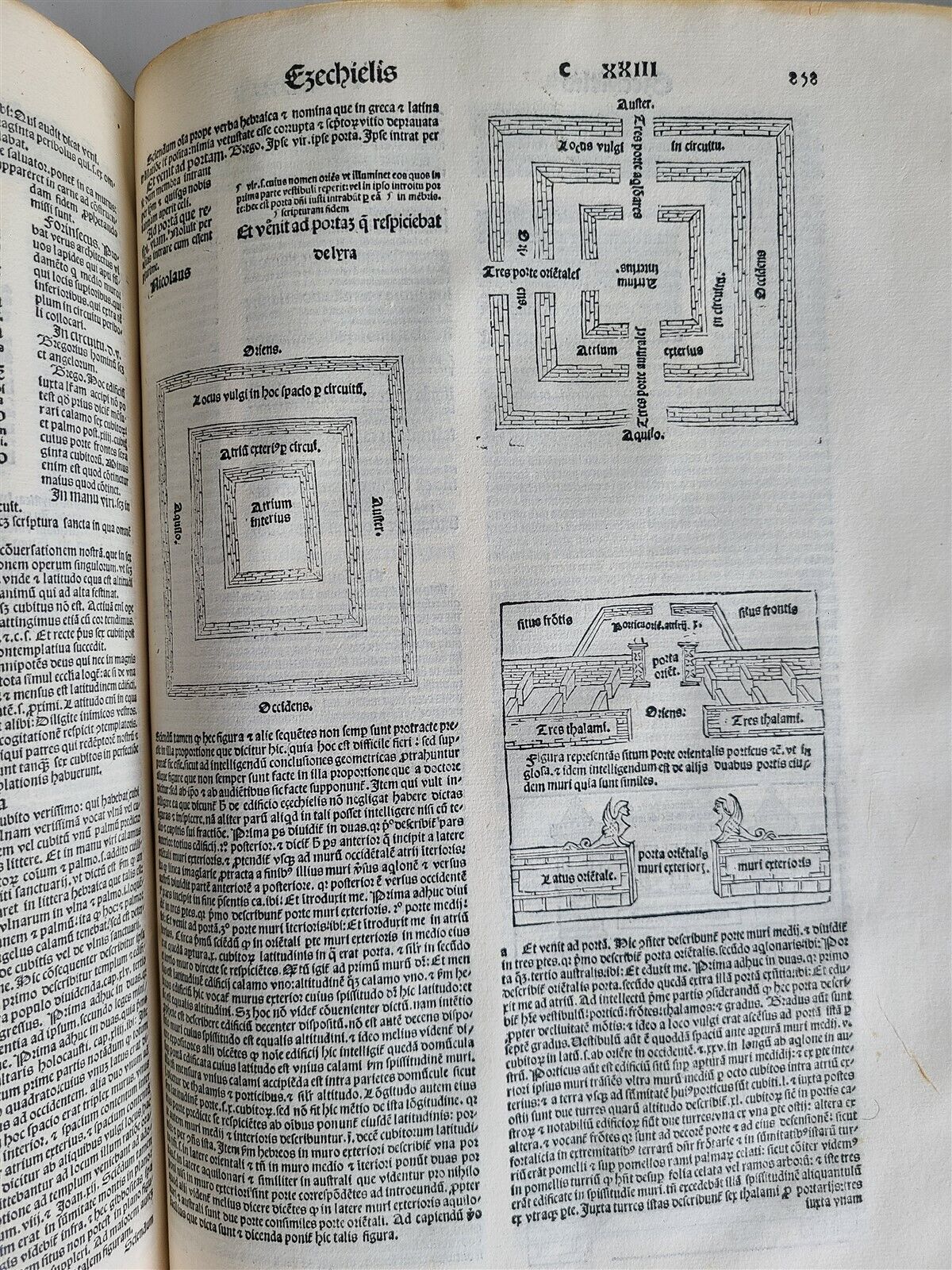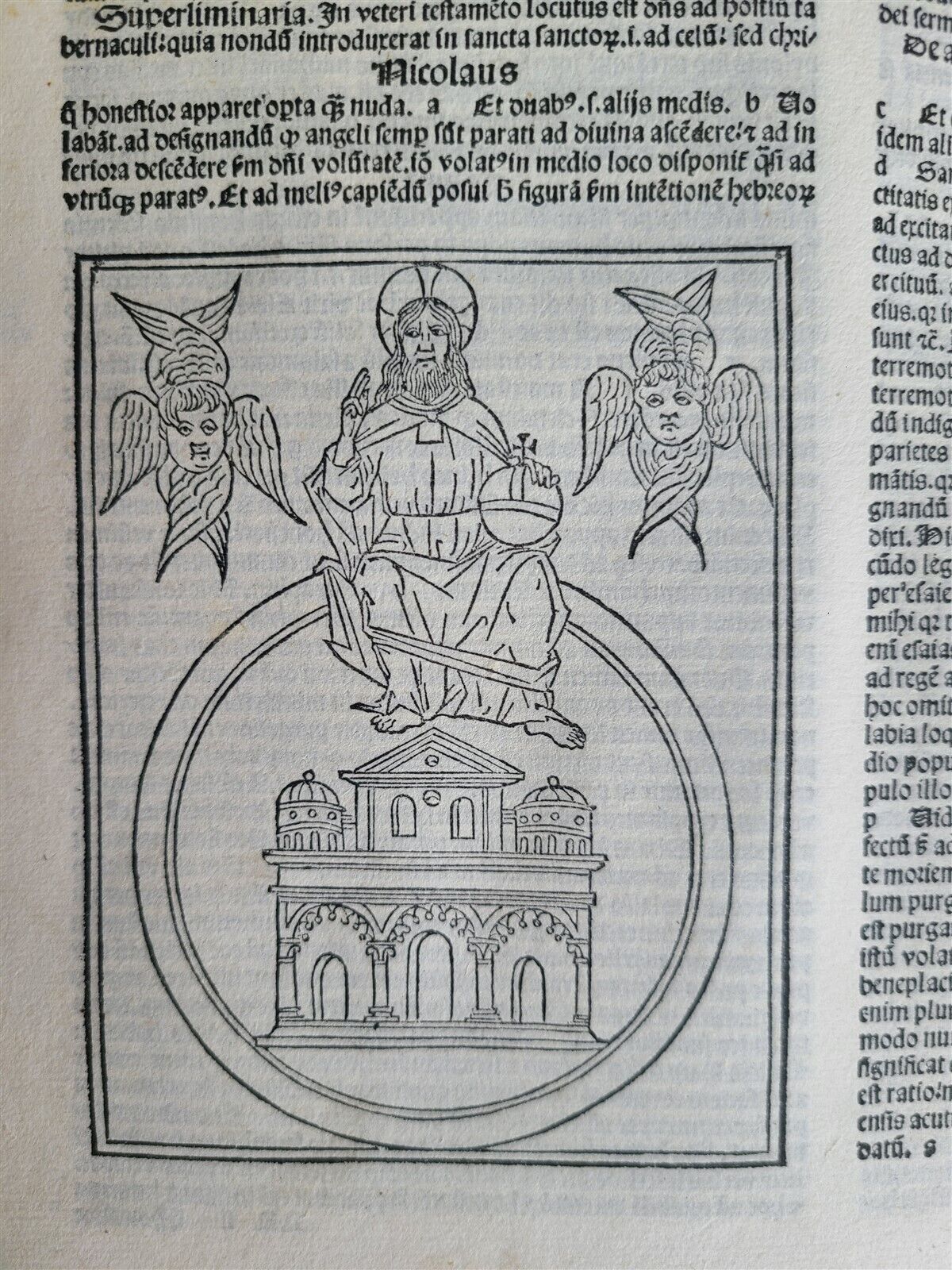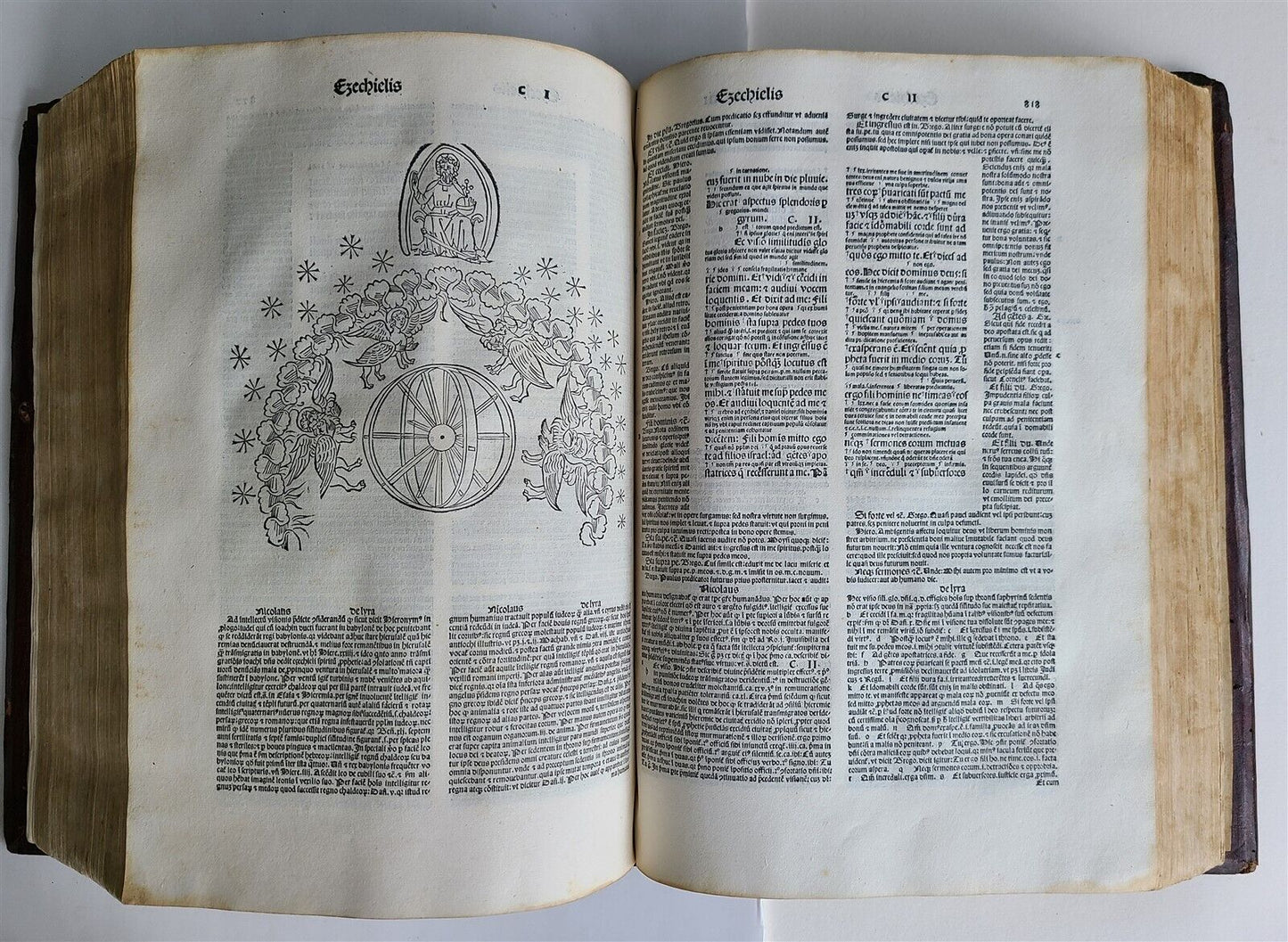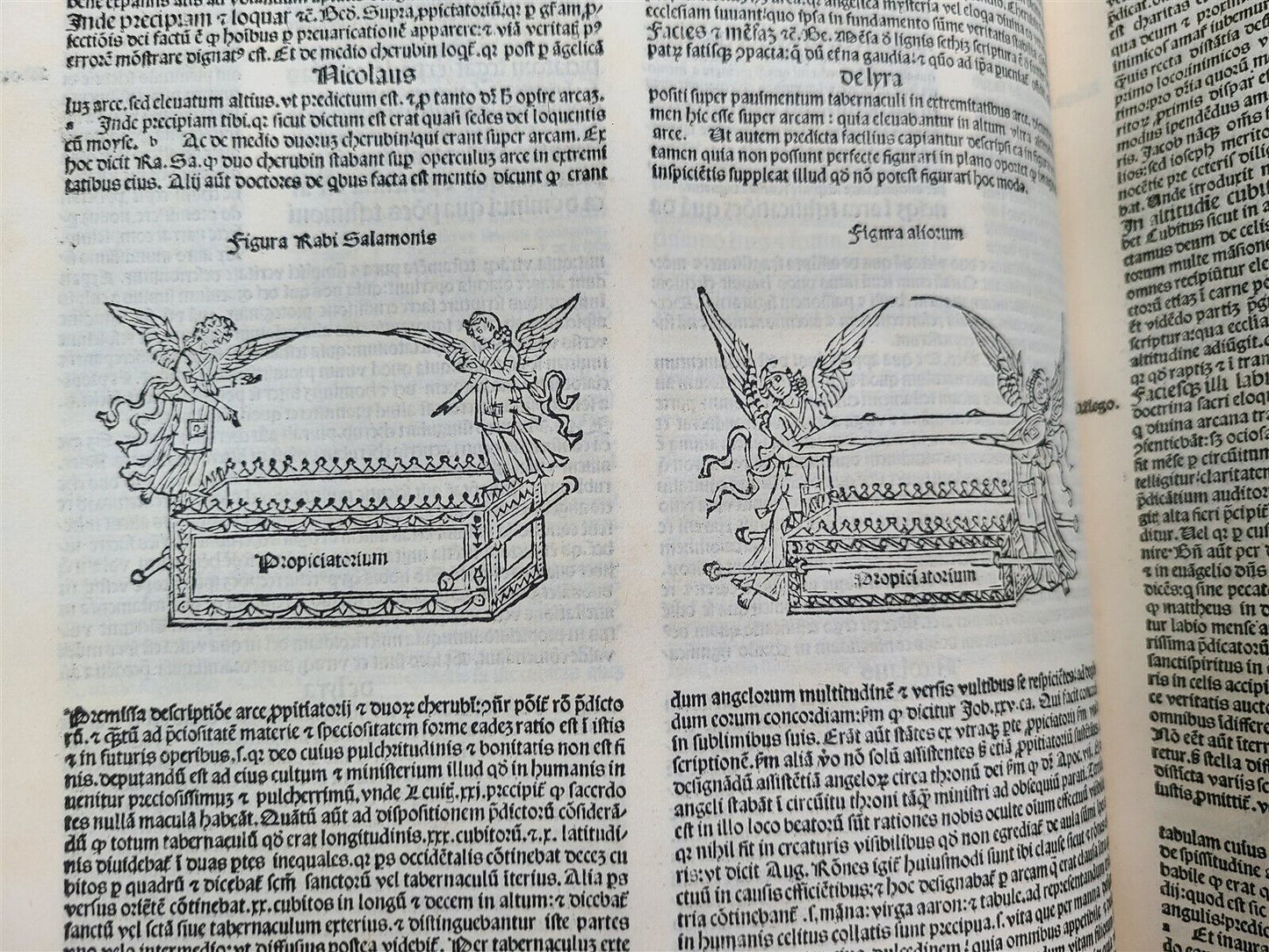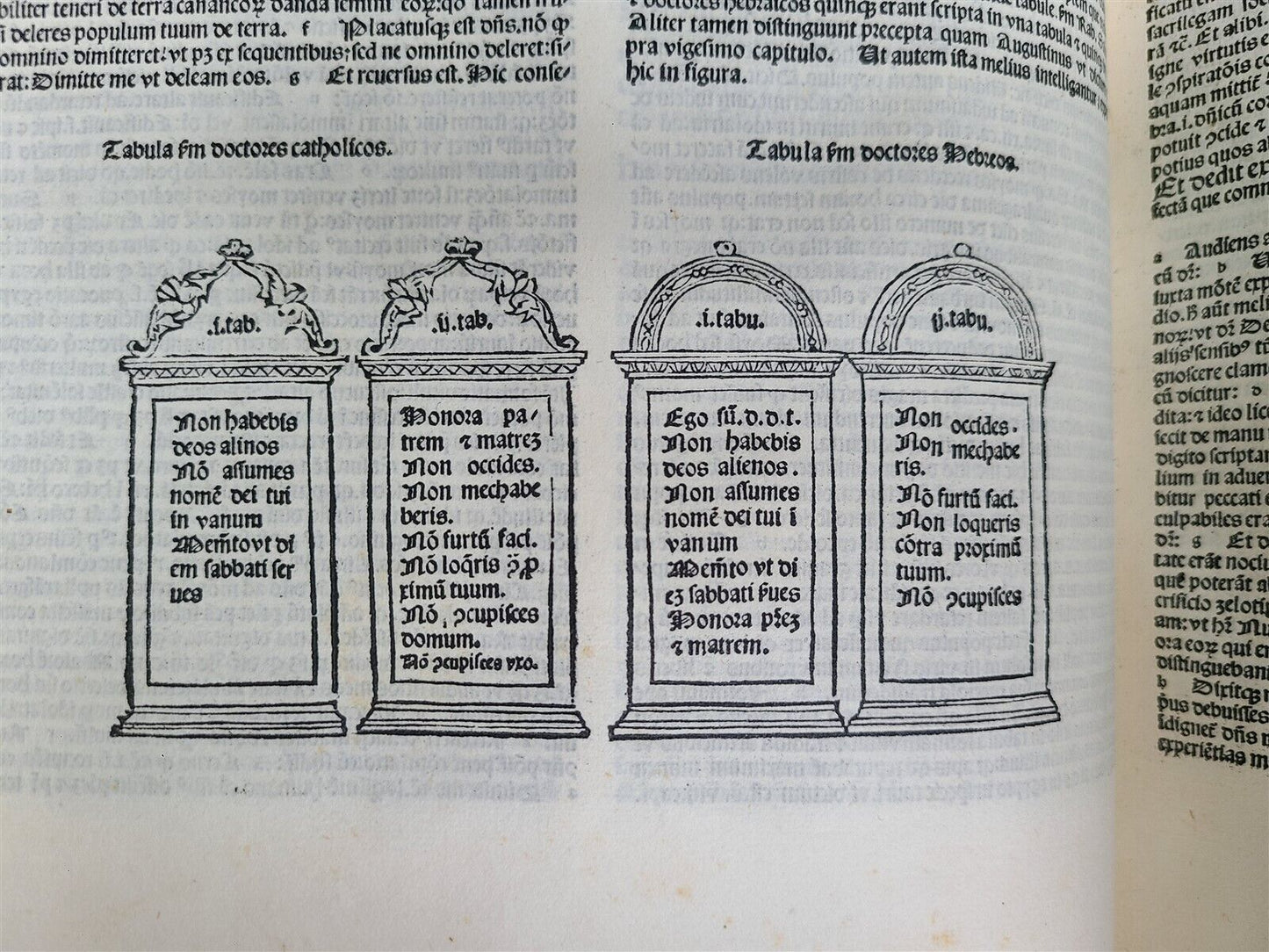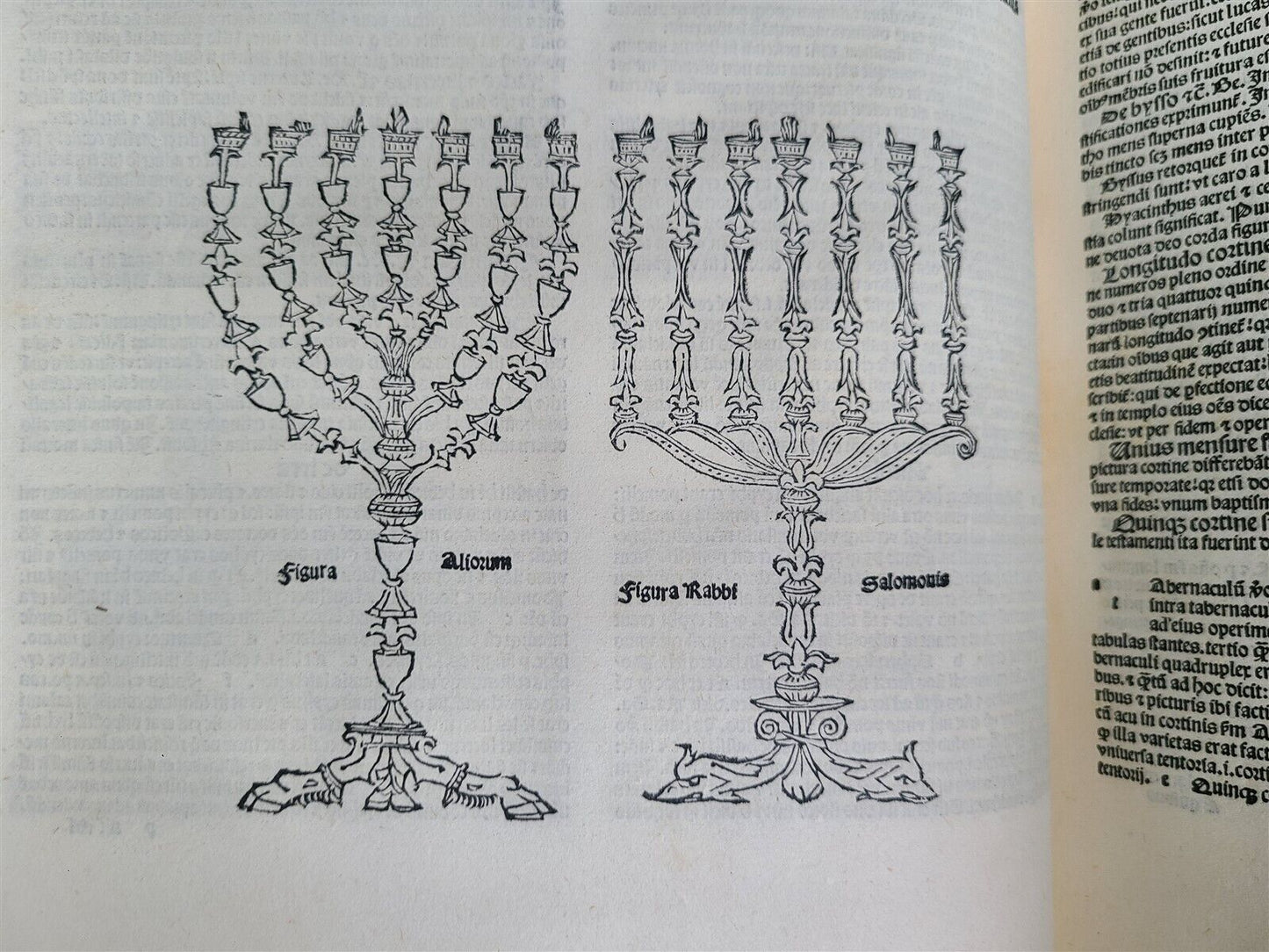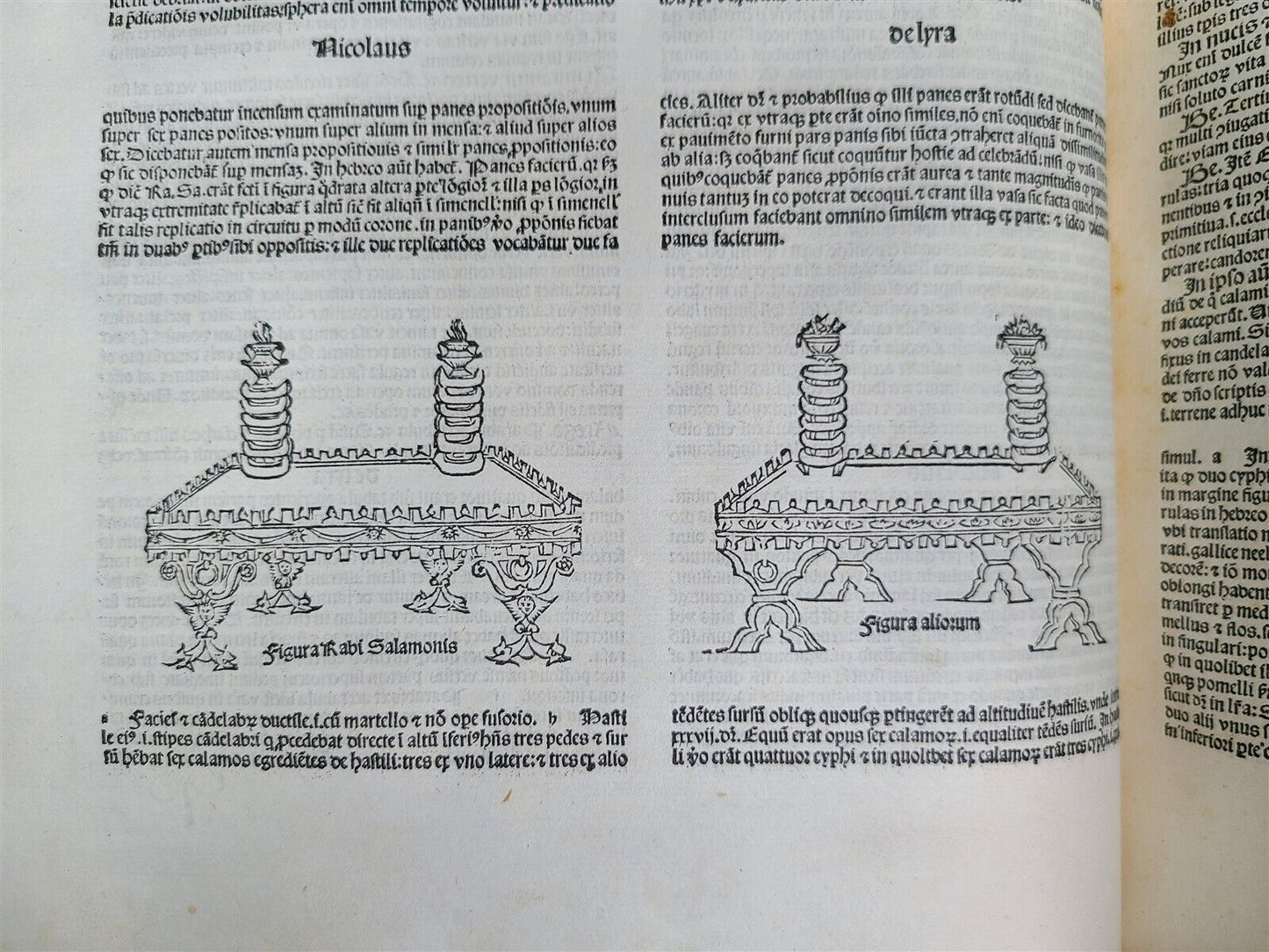Motka
1495 INCUNABULA BIBLE 3 FOLIO VOLUMES COMPLETE antique ILLUSTRATED BIBLIA LATINA
1495 INCUNABULA BIBLE 3 FOLIO VOLUMES COMPLETE antique ILLUSTRATED BIBLIA LATINA
Regular price
$20,300.00 USD
Regular price
$29,000.00 USD
Sale price
$20,300.00 USD
Unit price
per
Couldn't load pickup availability
img{max-width:100%}
BIBLIA LATINA CUM GLOSSA ORDINARIA WALAFRIDI STRABONIS
ALIORUMQUE ET INTERLINEARI ANSELMI LAUDUNENSIS ET CUM POSTILIS NICOLAI DE LYRA EXPOSITIONIBUSQUE GUILLELMI BRITONIS IN OMNES PROLOGOS S. HIERONYMI
Printed in Venice by Paganinus de Paganinis, 18 April 1495.
Text in Latin.
Edited by Bernardino Gadolo of Brescia and Secondo Contarini;
with Gadolfo's dedicatory preface addressed to Cardinal Francesco Todeschini Piccolomini, the future Pope Pius III.
Bound in 3 MASSIVE THICK FOLIO VOLUMES: 10 1/4 by 14 3/4" (leaves measure 36 cm x 25 cm)
comprising over 3000 pages in total,
ILLUSTRATED WITH 54 WOODCUTS
First two volumes bound in a splendid original ca. 1500 Venetian blind-tooled brown goatskin over thick wooden boards;
covers decorated with arabesque knot-work centerpieces enclosed in concentric borders of floriated and 'winding vines' rolls;
spines very neatly rebacked retaining most of the original backstrips blind-ruled to a cross-hatched diamond pattern.
Both of these volumes originally had four clasps each; all are now gone, retaining, however, small brass nailheads at edges of the front cover, where the clasps' straps used to be attached.
The 3rd volume in a very tastefully produced modern binding of brown polished morocco over wooden boards blind-tooled to match the style of the original Renaissance bindings on the 1st two volumes.
A fragment of a 13th-century(?) vellum manuscript used as a spine liner, with a portion visible at gutter over front free endpaper in Vol.I.
Foliation: [13], 1398 [i.e. 1498] leaves (forming 1511 leaves, i.e. 3022 pages in total).
Foliation continuous throughout all three volumes. (Numerous errors in numeration.)
Signatures: a8 b6[-b6 last preliminary] c-z8 [et]8 [con]8 [rum]8 2a-2d8 2e-2f6 2g-2r8 2s-2v6 2x-2z8 2[et]8 2[con]8 2[rum]8 3a-3p8 3q-3r6 3s-3z8 3[et]8 3[con]8 3[rum]8 A-V8 X-Y6 Z-3S8 3T10 3V-3Z8 1-438 4410.
COMPLETE, except only for the last preliminary leaf b6 (prefatory material to the Glossa Ordinaria) before the beginning of Genesis.
The Biblical text is complete;
the title-page and the colophon are present.
Inner blank ff6 is present.
Biblical text printed in double columns, interspersed with interlinear glosses (in very small type), surrounded by commentary (Lyra's Postilla and Glossa Ordinaria);
83 lines of gloss per page.
All text in Gothic types of various sizes:
Type: 5:79G, 10:92G, 10*:130G, 11:270G, 13:68G, 14;102G, 15:54G.
Capital spaces with guide initials (unrubricated).
Title page (a1r) printed in red snd black, with a fine woodcut printer's device depicting St. Peter holding a pair of keys and a book (with printed motto "Tu es Petrus").
Further 54 woodcut (mostly large) illustrations in text.
Incipits on the first page of Genesis (c1r) printed in red.
Preliminaries include a short address to the reader 'Ad intelligentiam ordinis et signorum huius sacrosancti libri...' on verso of title page, followed by a dedicatory epistle by the editor Bernardino Gadolo to Cardinal Francesco Todeschini Piccolomini (future Pope Pius III);
a short prefatory note ('Translatores Biblie') on the translators of the Bible;
two prologues by Nicolaus de Lyra; St. Jerome's letter to Paulinus and his Prologue to the Pentateuch, both with Guillelmus Brito's commentary.
Nicolaus de Lyra's Contra perfidiam Judaeorum at the end of the last volume (447r-10r),
with the the Colophon on recto of the final leaf 447r (verso blank).
Verso of the same endpaper with (partially removed) 16th-century inscription, including the popular early 16th-century jocular verses on the importance of Lyra's commentary (with a play of words on his name): Lyra non lyrasset,] totus mundus delirasset', i.e. "Had Lyra not played the lyre, the whole world would have gone hay-wire ".
Very Good antiquarian condition.
All bindings tight and very solid, joints and hinges intact, all boards firmly attached. Internally, with occasional light soiling and mild marginal water-staining.
A few leaves lightly browned.
An inked-out early inscription to title page; a couple more pages with minor early manuscript marginalia.
Front free endpaper in Vol.I with top portion cut off and restored,
a 20th-century acquisition note in Italian on recto, and a 16th-century inscription (partially removed) on verso;
title page and the next preliminary leaf with very neat (and barely noticeable) marginal repairs at edges.
In Vol.II, a few leaves in the first quire with very neat archival repairs (affecting only a few words of commentary), and some leaves with two small marginal wormholes (in outer margin, not affecting any text).
Vol.III with a few leaves in the first and last quire with neat archival repairs (slightly obscuring a few words of commentary but generally without loss of legibility); several leaves in Vol.III with slightly heavier damp-staining, but mostly confined to the top margin.
In all, a very impressive and attractive set of this magnificent edition: solid, wide-margined, and clean, with the first two volumes retaining their original Venetian blind-stamped morocco bindings (of which very few have survived in such a large Folio format).
FIRST EDITION OF LATIN BIBLE TO INCLUDE BOTH THE GLOSSA ORDINARIA AND DE LYRA'S POSTILLA - THE TWO MOST IMPORTANT AND POPULAR MEDIEVAL BIBLICAL COMMENTARIES.
This is also THE FIRST PRINTED BIBLE TO USE CATCHWORDS
"This is a VERY HANDSOMELY PRINTED EDITION, with the Ordinary Gloss and the Commentaries of Nicolas de Lyra.
It is printed on thick, stout paper, with signatures, numerals, and catchwords. This is in fact the first edition of the Latin Bible in which catchwords are employed." (W. A. Copinger, Incunabula Biblica, no. 105)
"In 1492, the Venice printer Paganinus de Paganinis received a ten-year privilege for printing at considerable expense a Bible surrounded by the Glossa and the Postilla litteralis of Lyra, as well as Brito's prologue commentaries. This 1495 publication employed a complex system of small reference letters to match the Bible text with the two commentaries." (H. A. G. Houghton (Ed.), The Oxford Handbook of the Latin Bible, p. 279)
In this monumental edition of the Vulgate Latin Bible the complete biblical text is accompanied with:
The interlinear gloss of Anselm of Laon;
The Glossa Ordinaria attributed to Walafrid Strabo;
The Postilla super totam Bibliam of Nicolaus de Lyra;
The Expositions on St. Jerome's prologues by Guillelmus Brito;
and including (at the end of the last volume) a short tract against the Jews Contra perfidiam Judaeorum by Nicolaus de Lyra.
Although the foliation in this edition is continuous, it is usually found bound in 4 volumes;
this set, however, is bound in three enormous folio volumes:
Vol I - Genesis to Job;
Vol. II Psalms to Maccabees;
Vol. III: Matthew to Revelation.
The 54 handsome woodcuts illustrating this superb edition are from the Venetian edition of 8 August 1489, which was the first illustrated Latin Bible printed in Italy.
The Glossa Ordinaria was the standard biblical gloss during the Middle Ages, surviving in thousands of manuscripts and referenced constantly by Thomas Aquinas, Bonaventure, and other medieval theologians.
It was also used by John Wyclif and his contemporaries.
Comprised chiefly of excerpts from the patristic exegesis of Augustine, Jerome, Gregory the Great, and many others, the Glossa stands as a unique witness and aid to reading Scripture within the Church's Tradition.
The text of Glossa Ordinaria was arranged by scholars during the 12th century.
Although the compilation of the Glossa used to be traditionally (mis-)attributed to Walafrid Strabo, a 9th-century Benedictine monk from Swabia, it was mainly compiled by the French theologian Anselm of Laon (d. 1117) and his followers. However, the Gloss only achieved its standard, finalized form at Paris in the second half of the 12th century.
This is the 2nd edition of the Bible with the Glossa Ordinaria, but the First to combine it with Lyra's celebrated Postilla;
the 1st edition with Glossa Ordinaria was printed ca. 1480 by Adolf Rusch in Strasbourg, and was of great importance in the bibliographical history of the Bible; and the biblical text and that of the Glossa here follows the celebrated Rusch edition quite closely.
"The physical act of compiling the text must have been strenuous to say the least.
Rusch achieved this feat by figuring out the exact ratio of vulgate text and marginal glosses appropriate to each page, linking the latter to the vulgate by giving a lemma for each, and inventing a system of visual symbols to connect each interlinear gloss to its proper reference in the vulgate text on the line below.
The process may have taken years to complete. […]
We must wonder how Rusch succeeded, [as] there is no indication that he had any scholarly assistance. [...]
Given the tenacity with which scholars have attempted to trace the source of Gutenberg's Bible texts, it is rather astonishing that Rusch, no scholar himself, seems to have compiled the texts for his edition of the Glossa Ordinaria without external expert assistance.
"Rusch's edition was never reprinted, but the next edition of the Glossa Ordinaria was printed in venice in 1495 by Paganinus de Paganinis.
This text, printed in four volumes, added Nicholas of Lyra's Postilla. Froehlich suggests that for the vulgate text and the Glossa Ordinaria Paganinus 'followed quite closely the Rusch edition'. Of particular importance, the marginal gloss also follows Rusch in every textual detail."
(David A Salomon, LAn Introduction to the 'Glossa Ordinaria' as Medieval Hypertext, p.59)
Nicolaus de Lyra's enormous commentary, Postilla litteralis, was THE DEFINITIVE BIBLICAL COMMENTARY FROM THE MIDDLE AGES UNTIL THE REFORMATION, and is considered A MILESTONE IN THE HISTORY OF BIBLICAL EXEGESIS.
This edition also includes (at the end of Vol.III)
LYRA'S ANTISEMITIC POLEMICAL TREATISE Contra perfidiam Judaeorum which was later USED BY MARTIN LUTHER.
"Luther uses and cites Contra perfidiam Judaeorum by Nicholas of Lyra, a work written in the medieval genre of a defensio fidei. He argues that Lyra's description of the apostasy of the Jews is a 'right, good, and strong argument'. Jeremy Cohen states that Lyra began De Iudeorum perfidia […] as a scholastic discourse in 1309 and revised it in the 1330s."
(Archive for Reformation History, vol.28, p.144)
This magnificent set is embellished with 54 fine woodcut illustrations, which belong properly to the accompanying Postilla of Nicolaus of Lyra, a text with a long tradition of manuscript illustrations. This tradition did not immediately translate into print, since the printers of many early editions provided only blank spaces for the illustrations. The earliest version of these illustrations appeared in the separate edition of the Postilla printed by Koberger in 1481.
According to Paul Saenger, of Newberry Library these illustrations "are recognized as being based on [11th-century Jewish scholar] Rashi's drawings, many of which have been lost in the Hebrew manuscript tradition.
"These illustrations "are meant to be more than decoration: they are an essential part of the explanatory text."
(Ph. Krey, L. Smith (eds.): Nicholas of Lyra: The Senses of Scripture, p.11).
The woodcuts (mostly quite large) depict such popular Old Testament subjects as the Noah's Ark, the Tabernacle, plans of the Temple of Solomon and Jerusalem, the Sacrificial Altar, the Ark of the Covenant guarded by angels, the Tables of the Law (the Ten Commandments), the copper basin for the washing of hands and feet, the Great Menorah, the veil in front of the Holy of Holies, the desert encampment of the Tribes of Israel, the High Priest in his vestments, the vision of the prophet Ezekiel (depicting the Creator and the tetramorph, represented as a winged creature with four different haloed heads of a man, a lion, an eagle, and a bull, above which is Ezekiel`s 'wheel within a wheel,' by which God's chariot moves), etc.
Many of the woodcuts incorporate captions (inscriptions) which are hand-carved, thus providing superb early examples of the technique of chiro-xylography, which was commonly used in the early block-books.
==========================
Nicholas de Lyra (c. 1270 - 1349), a Franciscan theologian, born in La Vieille Lyre in Normandy (Northern France), who taught at the University of Paris, was among the most influential Biblical commentators of the Middle Ages. Lyra studied with the Jewish rabbis of Évreux, one of the medieval centers of Jewish learning, and was known for his knowledge of Hebrew language and Jewish exegetical sources, including the writings of Shlomo Yitzchaki, aka Rabbi Solomon (1040-1105), today generally known by the acronym Rashi. His knowledge was displayed in his massive "Postilla", in which he commented extensively on the entire Bible according to mostly literal senses.
The Postilla of De Lyra is considered a milestone in the field of biblical exegesis, not only for its completeness but also because of its use of Hebrew exegetical scholarship. It was used by generations of scholars, among whom John Wycliffe and Martin Luther. John Wycliffe acknowledged his indebtedness to de Lyra in his translation of the Bible from around 1388. Luther consulted and used the Postillae regularly throughout his career, especially for his translation of Genesis. He saw the work as a good exegetical and practical resource which provided a better understanding of the historical sense of the text. Luther wrote in his Tischreden (Table Talk) "Lyra's Commentaries upon the Bible are worthy of all praise. I will order them diligently to read, for they are exceedingly good, especially on the historical part of the Old Testament."
"The report that he was of Jewish descent dates only from the 15th century. He took the Franciscan habit at Verneuil, studied theology, received the doctor's degree in Paris and was appointed professor at the Sorbonne. In the famous controversy on the Beatific Vision he took sides with the professors against John XXII. […] It was to exegesis that Nicholas of Lyra devoted his best years. In the second prologue to his monumental work, Postillae perpetuae in universam S. Scripturam, after stating that the literal sense of Sacred Scripture is the foundation of all mystical expositions, and that it alone has demonstrative force, as St. Augustine teaches, he deplores the state of Biblical studies in his time. The literal sense, he avers, is much obscured, owing partly to the carelessness of the copyists, partly to the unskillfulness of some of the correctors, and partly also to our own translation (the Vulgate), which not infrequently departs from the original Hebrew. He holds with St. Jerome that the text must be corrected from the Hebrew codices, except of course the prophecies concerning the Divinity of Christ. [...] Hereupon he declares his intention of insisting, in the present work, upon the literal sense and of interspersing only a few mystical interpretations. Nicholas utilized all available sources, fully mastered the Hebrew and drew copiously from the valuable commentaries of the Jewish exegetes, especially of the celebrated Talmudist Rashi. […] His exposition is lucid and concise; his observations are judicious and sound, and always original. The "Postillae" soon became the favourite manual of exegesis. It was the first Biblical commentary printed. The solid learning of Nicholas commanded the respect of both Jews and Christians." (Catholic Encyplopedia).
"Lyra's most noted work is his Postillae Perpetuae in Universa Biblica, 'THE ONLY TRULY IMPORTANT MONUMENT OF CHRISTIAN EXEGESIS SINCE THE EPOCH OF THE CHURCH FATHERS' [Soury]. It is divided into the Postilla litteralis (1322-1331), which followed the literal sense in Biblical interpretation, and the Postilla mystica (1339), following the mystic sense. […] Lyra's exegesis was characterized by a very independent attitude towards traditional interpretations, by a remarkable historical and critical sense, and by a fidelity to the literal meaning of Biblical texts.
"For the enrichment of his works Lyra drew upon many sources […]. It was, however, to the 'treasures of the Synagogue' that he turned most frequently, making direct use of available Jewish sources. We have already mentioned his reliance upon the commentaries of the great Jewish exegete of Troyes, Rabbi Solomon Isaac, or Rashi. Like Roger Bacon, he spoke of the latter only in terms of praise. […] Thus Rashi's works passed almost entirely into the writings of the Franciscan monk who, like the Hebraists of the Reformation, may be called 'a disciple of the Rabbis'. Lyra transcribes him almost word for word, finding inspiration for the method of literal exegesis in Rashi's use of 'peshat', and making him the source for most of his information concerning Jewish traditions and customs.
"From the moment of their first appearance and dissemination until even the present day, Lyra's works have exerted a profound influence in the Christian world. The translators of the Latin and Hebrew Bible into the vernacular languages of Europe turned to his commentaries for assistance. […] The German Reformers, among them Melanchthon, Urbanus Rhegius and others, consulted Lyra repeatedly, and Luther owed to him much of the knowledge he possessed of Rabbinical literature, particularly of Rashi; in his interpretation of Genesis he followed Lyra point by point. […] In the writings of Servetus, Zwingli, Calvin and many others, Lyra is constantly cited, a fact which is ample indication of his importance, not only in orthodox Catholic, but in Protestant circles as well.
"In fact, it may be said that prior to the Reformation and the rise of scientific grammatical aids to Christian Hebraists, no single individual made the imprint of Jewish and Hebraic scholarship upon Christian interpretation and doctrine so profound as did Nicholas Lyra. The Jewish tradition found in him one of its most powerful bearers and transmitters the more Jewish his scholarship; the more potent was his influence." (Louis Newman, Jewish Influence in Christian Reform Movements, p.62-5)
The Vulgate Bible is an early 5th century Latin version of the Holy Scriptures, translated from the Hebrew and Aramaic by St.Jerome between 382 and 405 CE, on the orders of Pope Damasus I. It takes its name from the phrase versio vulgata, "the translation made public", and was written in a common fourth-century style of literary Latin in conscious distinction from the more elegant Ciceronian Latin. The Vulgate improved upon several translations then in use, and became the definitive and officially promulgated Bible version of the Roman Catholic Church. Through the Middle Ages and into the Renaissance and Reformation, St. Jerome's monumental work stood as the bedrock of the Roman church as it strove to unite a fractured Europe through the Catholic faith, while also exerting a powerful cultural influence, especially through art and music.
Bibliographical references:
Hain-Copinger *3174; Goff B-608; BMC V 458; GW 4283; Proctor 5170; BSB-Ink B-473; Oates 2028-9; Essling 137;
Sander 994
===============================
Please see my other auctions
Thank You
Refund Policy: We will issue a FULL REFUND, 100% money back if you are not satisfied with your purchase. Items must be returned to us within 20 days in order to receive a refund or replacement. Buyer is responsible for shipping costs.
Powered by SixBit's eCommerce Solution
View full details

